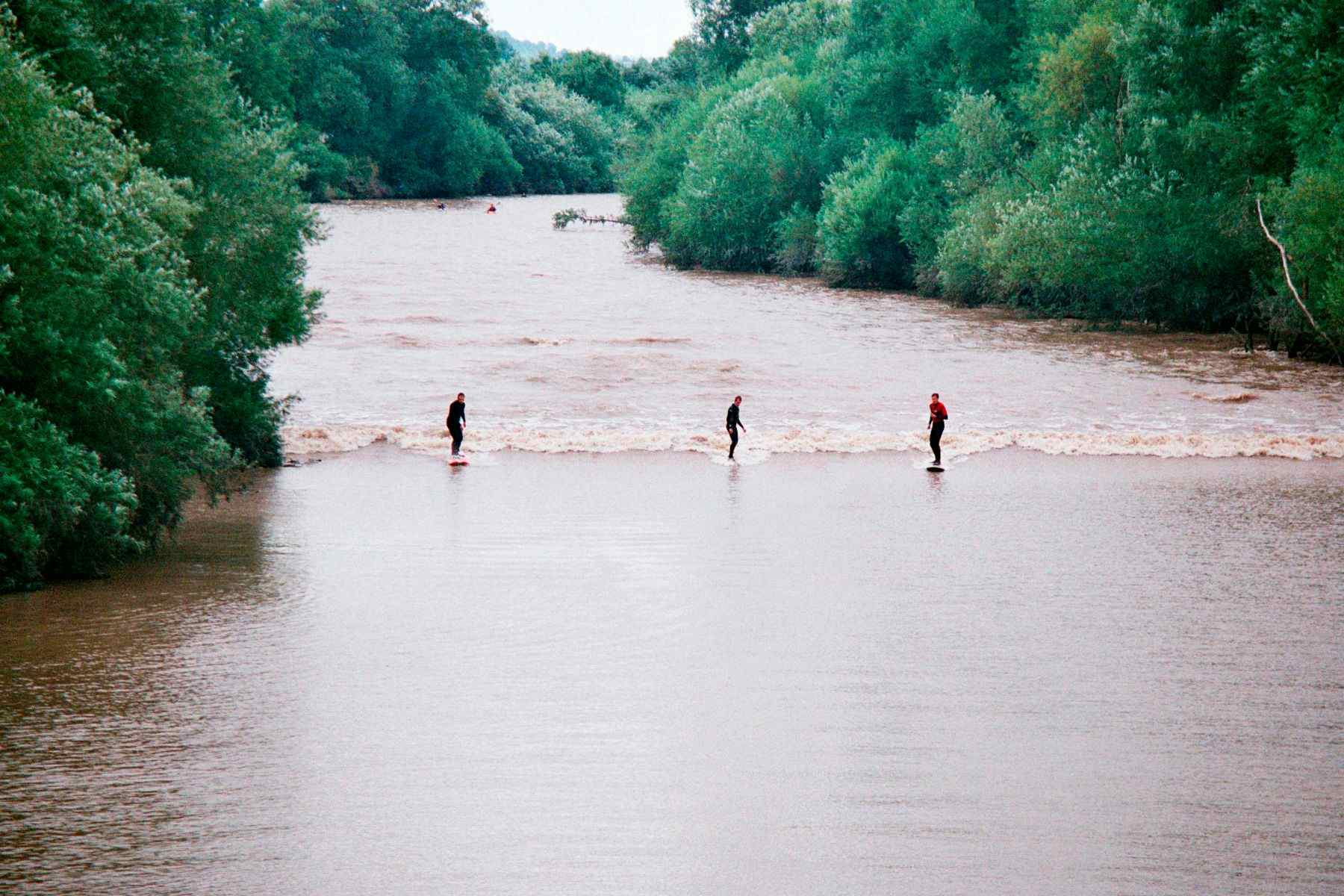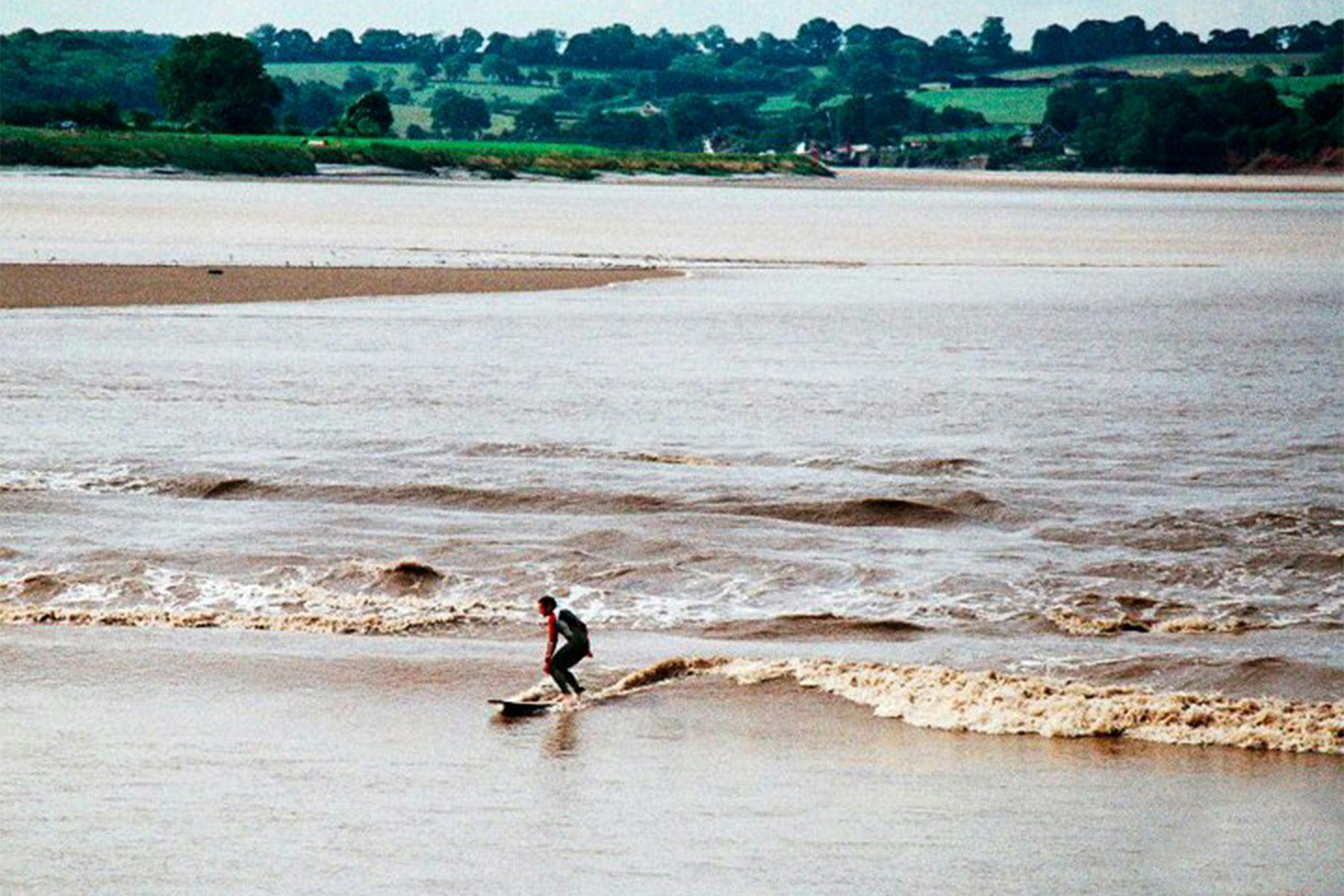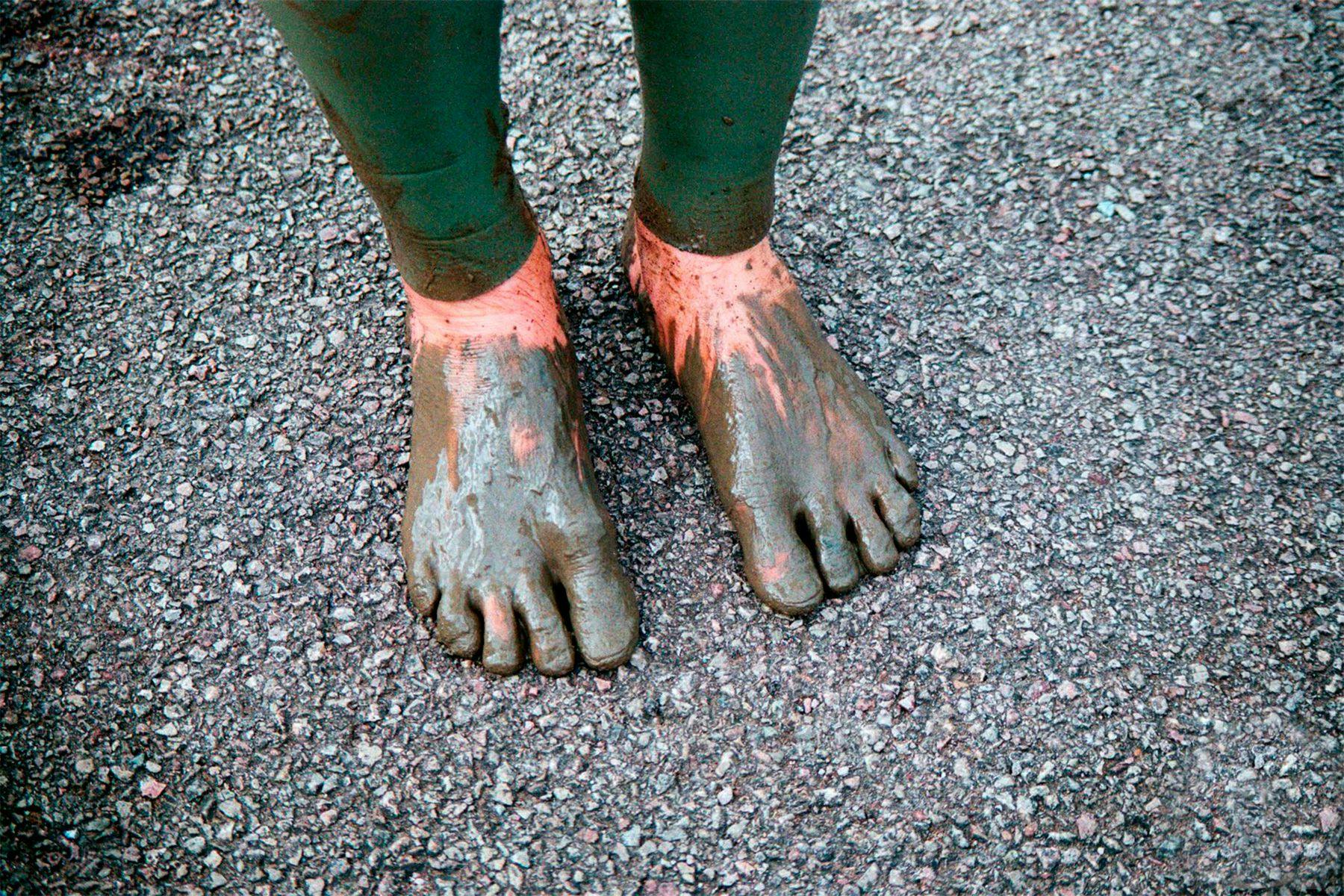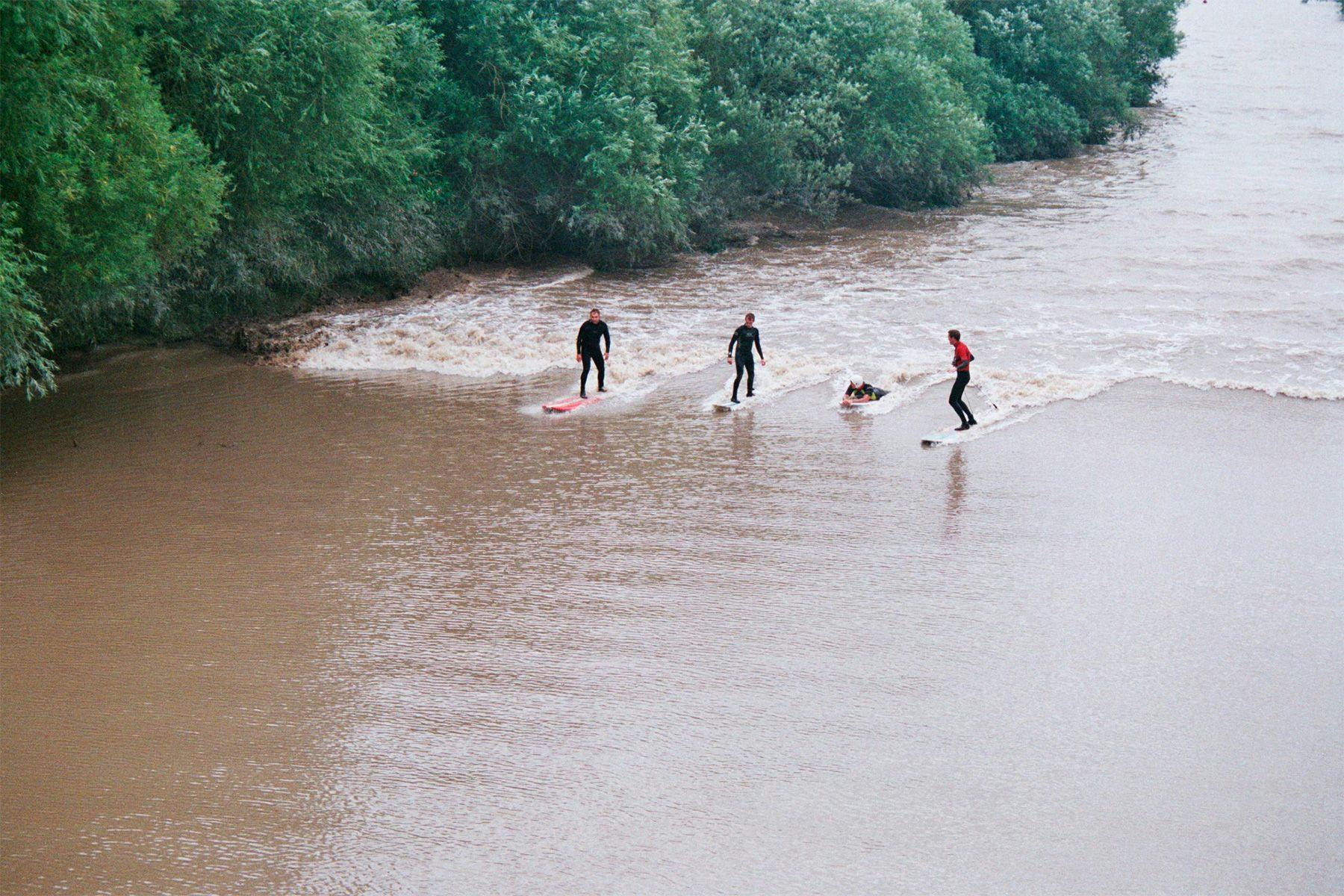Nature, Surf cultureSurfing The Severn Bore: The Muddy Brothers and Their Memories

You hear it before you see it. A distant rumble, deep like thunder, crescendos until sight catches up with sound. The wave appears. A rushing, tumbling, noisy mass, the wall of water pushes upriver. It consumes the mudflats and sandbanks of the riverbed. It scours the banks with a wash of tidal water. It propels the surfers, to the delight of the watching crowd, upriver on its open face as far as they can ride it.
The Severn Bore is a tidal river wave in the Severn Estuary (UK). The tidal range here is the second largest in the world, a difference between low and high of up to 15 metres, creating an intertidal area of 9,981 hectares. Topography also plays its part in creating the wave: the wide estuary narrows and the estuary bed gently shelves up towards the river mouth. As the tide rises, the waters are funneled until, constrained by their surroundings but containing the kinetic energy of the tidal flow, they rise as a wave. The tide travels inland approximately twenty miles to Gloucester, where Maisemore Weir, a manmade structure, absorbs the power of the wave (and even bounces it back downriver, against its own trailing surge).

The tidal wave, or bore, occurs regularly throughout the year; it is a predictable natural spectacle. There are river bores elsewhere in Britain, and around the world: the Rivers Trent, Dee, Ouse, Ribble and Parrett (UK), to name a few, have tidal bores, though smaller than the Severn’s. So too do the Garonne and Dordogne in France (and until the 1960s, when river dredging eliminated it, the Seine); the Petitcodiac in the Bay of Fundy, Nova Scotia (which has the world’s highest tidal range); the Turnagain arm of Cook Inlet, Alaska; the Colorado River also used to have a far-reaching tidal bore, until damming interrupted the movement of water; the Amazon (Brazil); the Orinoco (Venezuela); and the Turama and Fly rivers (Papua New Guinea). The Qiantang (China) forms a tidal bore, dubbed the ‘Silver Dragon’, during the city of Hangzhou’s mid- autumn festival and draws crowds of thousands. This is by no means a comprehensive list, and many more rivers are affected by tides and experience tidal surges that move upstream. The presence of a bore itself is not unique. The Severn estuary is connected to these other, distant, rivers, by the shared recurrence of the tidal wave. But the ways in which the bore has shaped the Severn River environment, and how local people have responded to it, are particular to place.
There is a strong tradition of oral and written history surrounding the Severn bore, with the more recent oral history enabling an appreciation of the depth and nuance of river knowledge held within the community of river surfers, which is underrepresented in the historical archive and in recent debates over the future of the river. The written accounts date back many decades, with archives from the local newspaper revealing references dating back as far as 1764. The [written] accounts vary in their descriptions. Some contributors are most interested by the underlying topographical causes of the bore— “the cause is, I suppose, the extreme wide and direct mouth of Severn, lying open to the vast Atlantick Sea where the tide comes rolling in a-main.” Others record the qualities of the bore, and note the number and behaviour of crowds who gathered to watch:
“The phenomenon of the ‘Bore’ was seen to advantage at a point on the Severn called Stonebench, about three and a half miles below Gloucester, by Quedgely, and was there witnessed on Thursday morning by a large number of persons from the city and elsewhere, in an imposing array of vehicles of all descriptions … the distant roar of the advancing wave was heard, and almost immediately a foaming crest, dashing up the two steep banks and fretting against the willow trees planted thereon, rushed furiously by.”
These accounts trace a tradition of gathering to watch the bore along the Severn. They extend our knowledge of recreational engagement with the bore.
The first documented bore surfer was Colonel Jack Churchill, war- time commando and later an instructor at an Australian military school, where he learnt to surf. Back in the UK, he approached Fred Rowbotham, a local bore expert (but non-surfer), to assess the possibility of riding the river wave. On 21 July 1955, he paddled out at Stonebench and caught the first Severn Bore known to be surfed on a board. Since then, and linked to the rise in popularity of surfing along Britain’s coastline, increasing numbers of surfers have sought out the bore. On ‘good’ (predicted 4* and 5*) bores, there will be tens to hundreds of people in the river at different points along its stretch. Unlike regular sea surfing, the etiquette here allows for multiple surfers on the one wave, who line up and negotiate the wobbles and turns of their neighbours to stay upright for as long as possible. This distinct community of “muddy brothers” (the surfers are largely, but not exclusively, male) has been the focus of my academic research. I wanted to know how a deep and detailed sense of place has emerged through repeated sporting practice, and I want to place the surfer’s knowledge of the river alongside the better-known narratives of river use in Britain, to explore how recreational knowledge informs environmental knowledge, and vice versa.

I anticipated that this research would maintain a largely twentieth- century focus, in line with the temporal span of surfing on the river. But the records in Gloucester archive showed that recreational engagement with the bore is not the exclusive domain of thrill-seeking twentieth- century surfers. Surfing is the latest incarnation of a longer tradition of river use that actively engaged with the tides. No-one surfed the bore in the nineteenth century, that we know of, but an intrepid “party of ladies met it in a boat, which easily rode over the incline, and then swiftly moved upriver with the current.” There is a notable absence of women in my bore research, so these ladies are a welcome indicator that the river was not a strictly male preserve in the past. An earlier mid-eighteenth- century account also describes men meeting the tide in boats.
In an account from 31 August 1882, the author—who remains anonymous—writes that “at 9.20am some boys perched high in a tree shouted out the warning, ‘Flood O! Flood O!’ and then to a minute of her time, up came the bore, sweeping with a magnificent curve around a bend in the river”.
The author then notes that:
“… as the wave approached nearer and nearer, the ‘voice of many waters’ accompanied by a strange and sudden blast of cold wind, was truly awe- inspiring. In an instant, the bore swept past us with a might rush and the whirl of a thousand Derby’s passing … we all cheered the bore as she passed, so grandly were Nature’s race horses running their course …. An old man told me that this was as good a head as he had seen for forty years.”
A key difference between contemporary bore watchers and earlier observers is the presence of the surfers on the water. The wetsuited wave-riders bring aspects of skill, and thrill, to the scene, as they dance the fine line between balanced gliding on the wave and unexpected wobbles that threaten to dispatch them into the river water. In 2014, Sky News broadcast live helicopter footage of the Severn Bore progressing upriver, ridden by surfers. As they lined up on the wave, the commentator said “It’s like the Grand National coming your way, Tessa—the runners and riders and fallers!” But as the 1882 account documents, this way of framing the bore—and the surfers on it—as a sporting spectacle, and specifically invoking the image of a horserace, is not new. There is a continuity in how people have reacted to and represented the bore that is not dependent on the presence of the surfers. However, that presence has complemented, and enhanced, the framing of the bore as a race. If in the nineteenth century the wave itself was seen to race along, in the twentieth century it gained its riders.

THE ‘MUDDY BROTHERS’: A GROUP INTERVIEW
In 2017 I joined a number of the Severn bore’s regular surfers, a group often referred to as “The Muddy Brothers”, for a day on the river observing several of them surfing the bore from a boat. They included Steve King, Nate Maurice, Stuart Ballard and master mariner Duncan Milne. The conversation that followed later that morning in a nearby café was revealing. If we return to the documentary account of the bore mentioned earlier, we note the phrase used by the “old man” that the bore in 1882 was “as good a head as he had seen for forty years.” The meanings of this phrase were unfamiliar to me. Yet talking with the surfers, Steve and Duncan in particular both repeatedly referred to the bore as “the tide” and “the rising tide”. On one section of the river we were ahead of the bore in the boat, motoring over some very shallow water with a sandbank in the middle. This section was known as ‘The Noose’ because of the way the bore splits in two and travels at speed down the sides of the sandbar, before coming around to fill in the space. Steve’s description of the two “heads of tide” made perfect sense in this setting, where we watched the two surges meet and swirl together, create a temporary whirlpool and continue on as one ‘tide’. The terminology of the texts was alive and in use by the surfers.
Steve reflected on how well he had come to know the river:
“Well, I’ve lived in and around the river all my life, my grandparents worked on the river and on the narrowboats on the canal, so the family has always lived around the river. I started surfing when I was about 14 or 15, and then obviously this is on your doorstep so this is my local wave. Everyone has got somewhere that they are local.”
I asked Steve about acquiring the skill to surf the wave, and Duncan interjected “Knowledge!” Steve agreed:
Steve: Local knowledge is really key to it. It is the same when we were going down to meet the tide [bore], where the sandbars are, where we [that day] were saying “hold on! We are going to bottom out” and that, you’ve got to know. If you look at the expanse of water, most of the time you don’t know what is underneath it. But we know what is underneath it.
Interviewer: So it is like a constant relationship with the river where you are taking notice of how it is changing, and how it is working.
Steve: Yeah. There is a certain amount, a part of the river, that is consistent and it will never change, because that is solid reef and granite rocks. And down in the estuary it changes everyday.
Duncan: Overnight.
Steve: Yes, overnight. Phil was saying it was not so good today [the day of the interview] but yesterday, in some places, [the bore] was really good. At ‘The Denny’, Nathan surfed it last night and it was very good—today, no wave at all. And that is all about the conditions on the day.
Stuart B: The more years you’ve been doing it, the more bores you’ve surfed, you get this nice big database in the back of your head. Very nuanced little signals go off—–you’ll see a splash and think, oh, it did that when it broke over there, so you are constantly, or I, anyway, am constantly accessing my memories
Through talking about the bore, the men revealed a depth of place- knowledge that was the product of a lifetime of playing and working in and on the river. That depth is physical, as well as temporal. To newcomers, the muddy Severn waters (notoriously brown) obscure the river bed and subsurface environment. The river exists on a two-dimension visual plane. The bore disrupts this perception: as the wall of water advances it presents a glimpse into the three-dimension aquatic environment. As their observations reveal, the surfers are acutely aware of the river as an entity of vertical depth and horizontal motion in which flow not only connects, but reflects, the river environment bounded by land. So where alterations occur downstream, eddies and currents further up ‘speak’ to the surfers of an ever-changing environment. They ‘listen’ as subtle changes, such as shifts in sandbanks, impact on the bore as they experience it through surfing it. The stakes are high, as a fall in an unsuitable place means the surfer is tumbled around by the moving waters, potentially (and most dangerously) into the riverbank or overhanging trees. There have been no recorded deaths from surfing the bore, but the river has its dangers. Steve King has fished out five dead bodies over the years, including a man the day before our trip. Among the surfers, river knowledge is not treated as a luxury but as a necessity, acquired through repeat practice and time spent in and around the river, and is valued highly.

The Severn currently faces large-scale development of tidal lagoons in the outer estuary area. Its huge tidal range has attracted proposals to harness it for energy since the turn of the twentieth century, when an engineer named Alfred Liversedge proposed an electricity barrage in 1904. Post-World War I, schemes were discussed by the Board of Trade and Ministry for Transport in the 1920s, followed by further (unsuccessful) proposals in the 1950s, 1970s, 1980s and 2000s. Plans to fully barrage the estuary have, in recent years, shifted towards the notion of tidal lagoons along the edges. The Tidal Lagoon Swansea Bay project has been granted permission to build, though recent government changes to renewable energy subsidies mean that the plans are on hold. Barrage proposals have, down the years, been protested by a coalition of interests concerned by the impacts such a structure would have on the tidal environment of the estuary and lower river. The Royal National Society for the Protection of Birds (RSPB) and the Bristol Port Authority, for example, agreed that by impeding the tidal movements of the area, the movement of both large container ships in and out of the ports, and of migratory birds in and out of the area, would be vastly, and damagingly, reduced.
Some surfers organised to protest barrage proposals by forming a ‘Save Our Severn’ group. Founder Stuart Ballard established a festival (‘The Magnificent Severn’) in 2009–2010 on the banks of the river “to point out to people what a brilliant thing we’ve got already.” The Severn Bore was billed as a headline act alongside local bands. The group I interviewed oppose the tidal lagoon plans, and feel sceptical of the community consultations undertaken to date. The company behind the plans have not “been to Bore surfers or any of the community up here”, even though Steve King points out that they are based in nearby Gloucester, adding “How do you get planning permission to build something [in Swansea, Wales] but the impact is felt in another county [Gloucestershire, England]?”
The surfers have an acute sense of how the river connects places, communities and environments. The flow of water downriver, and movement of tides up it, mean that developments from source to estuary will be felt by those who live along the river. This idea has been central in the development of water law in Britain and elsewhere, whereby those down- stream are protected from actions upstream that may pollute or restrict water flow. But because of the tidal flows upriver on the Severn, the surfers are correct that any obstructions to the tide downstream will also impact those upstream. They claim, furthermore, that even the construction of the Second Severn Crossing in 1996—a bridge that has concrete supports in the water, and does not seek to impede the tide at all—has impacted the strength and shape of the bore.
Duncan: “Steve and I have said this for years, that when they built the Second Severn Crossing there has been a definite change in the river. For instance, the world record distance was always held ending at Maisemore Weir [Steve is the world-record holder for the longest stand-up surfing ride on a river bore, a feat he achieved by surfing 12.23 km up the Severn in 2006]. It depended upon the wave staying whole over a 12-mile distance but almost coincidental with building the second crossing, that section towards the weir has almost never worked. The actual record run has never worked since. And although we’ve had a stay of execution on the Severn Barrage, we are now facing a very real possibility of masses of money coming in from China to build these lagoons. And they are definitely going to upset the upper part [of the river].”

By following the water upstream, the surfers are able to move as Severn salmon do, against the normal flow. They break beyond the bounded ways in which most people conceive of rivers and have acquired an awareness of watercourses as connected environments, in which upstream affects downstream and vice versa. By being present on/in the river regularly, they have assumed an unofficial guardianship of the river environment, which prizes its ecological health and maintains a connection between the river and local inhabitants yet remains largely unrecognised by local government.
This text is adapted from an academic article by Dr Dudley titled River of Many Voices: Oral and Environmental Histories of the Severn that appeared in Telling Environmental Histories (published by Palgrave Studies in World Environmental History, K. Holmes and H. Goodall (eds.), 2017).